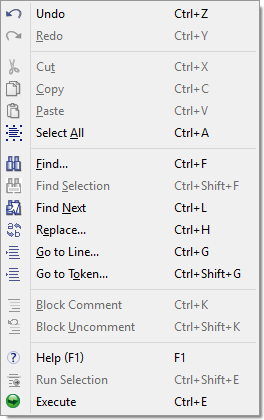Editor Pane Toolbar
When an Editor pane is active, the toolbar appears as below.

Icon |
Command |
Description/Comment |
|---|---|---|
|
Execute/Stop toggle |
Execute or stop cycling; see the “Toolbar” topic for more information. |
|
New… |
Open a new data file in a new Editor pane. |
|
Open… |
Call a dialog allowing the user to specify a data file to open. |
|
Save… |
Save the active data file. |
|
Close |
Close the active data file. |
|
Undo |
Undo the previous operation. |
|
Redo |
Perform the previous operation again. |
|
Find… |
Open a Find dialog that allows the user to specify text to search for in the current file. |
|
Find selection |
Find the next instance of the currently selected text. |
|
Find again |
Search for the next instance of the text that was most recently specified in the Find dialog. |
|
Replace… |
Open a Replace dialog that allows the user to specify a global replacement operation (i.e., find all instances of A and replace with B ). |
|
Go to… |
Open a dialog that allows the user to specify a line number to move to in the current file. |
|
Comment selection |
Comment the selected text (on a line-by-line basis, if more than one line is selected). |
|
Uncomment selection |
Uncomment the selected text (on a line-by-line basis, if more than one line is selected). |
|
Run Selection |
Execute the current selection only. |
|
Editor Options… |
Open the Options dialog to the Editor page. |
|
Local Options |
Pull-down menu to switch off/on the Local Options: Line Numbers, Code Folding, Indentation Guides, Syntax Highlighting, and Word Wrap. See the topic on Local Options for details. |
|
Command help… |
Open Help to the definition of the command on the current line. |
|
Show/Hide Control Panel |
Toggle Control Panel display; see the “Toolbar” topic. |
|
Control Sets |
Pick control sets to display/hide; see the “Toolbar” topic. |
The Right-Click Menu in the Editor Pane
The following commands are available in the pane on a pop-up context menu. The commands are enabled/disabled as appropriate to the current context (i.e., whether text is selected, whether there are commands stored on the undo/redo stack, etc.).

Undo - Undo the previous operation. |
Redo - Perform (again) the most recently “undone” operation. |
Cut - Delete the selected text and place it on the clipboard. |
Copy - Copy the selected text to the clipboard. |
Paste - Insert the text on the clipboard to the current cursor location. |
Delete - Delete the selected text. |
Select All - Select all text in the pane. |
Find… - Open the Find dialog. |
Find Selection - Find the next instance of the currently selected text. |
Find Next - Find the next instance of the text that was input in the Find dialog. |
Replace… - Open the Replace dialog. |
Go to Line… - Open the Go To Line dialog; enter a number to go to that line. |
Go to Token… - Open the Go To Token dialog; enter a number to go to the token at that position in the current line. |
Block comment - Comment the selected text (on a line-by-line basis, if more than one line is selected). |
Block uncomment - Uncomment the selected text (on a line-by-line basis, if more than one line is selected). |
Help (F1) - Open the Help file to the definition of the command on the current line. |
Run Selection - Execute the current selection only. |
Execute - This command is the same as the “Execute/Stop” command toggle on the toolbar. Use it to start or stop executing all of the current file. |
| Was this helpful? ... | Itasca Software © 2024, Itasca | Updated: Nov 12, 2025 |




















